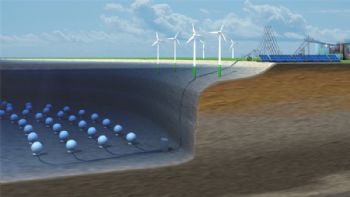
Since early 2013, a three-year consortium-backed project led by Germany’s Fraunhofer Institute for Wind Energy and Energy System Technology (F-IWES) (
www.iwes.fraunhofer.de/en.html) — and supported by Hochtief Solutions — has been developing plans for a new design for marine-based energy storage.
A pilot version is now ready for testing. The engineers say that the Stored Energy in the Sea project represents “a novel pumped storage concept aimed at facilitating the large-scale storage of electrical energy that is cost-competitive with existing solutions”.
According to Jochen Bard, head of energy process engineering at F-IWES, the technology “leverages water pressure
to drive electro-mechanical pump components housed within a central tube of submerged spherical storage units.”
These spheres, constructed of concrete, operate in a manner similar to pumped-hydro storage. It’s a straightforward principal that is similar to the conventional pumped-hydro system featuring upper and lower reservoirs. What we have is a pressure tank that maintains a lower pressure than the ambient pressure of the water-head above the device — the water column.
Assuming the tank is empty, it has a very low pressure. When you release water into the tank, the pressure of the water column is driving water through a turbine. This process generates energy and represents the discharge part of the cycle -— similar to water flowing through turbines, down into a lower reservoir, in a pumped-hydro system.
“As part of the project, we undertook a detailed analysis of eligible sites for the technology, using geographic information systems featuring a list of criteria.
“We see there’s great potential for the application of the technology. One site highlighted is the Norwegian Trench off the southern coast of Norway. Ideal site conditions were also identified in the Mediterranean Sea, the Pacific and Atlantic coasts of the USA, and Japan.